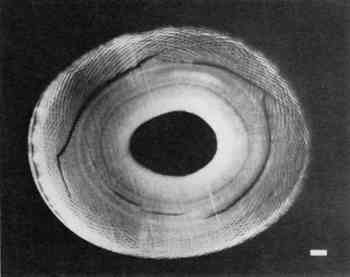THE HISTORY AND SIGNIFICANCE OF THE SCHREGER PATTERN IN PROBOSCIDEAN IVORY CHARACTERIZATIONEDGARD O'NIEL ESPINOZA, & MARY-JACQUE MANN
3 SIGNIFICANCEElephants are protected by the Convention on International Trade in Endangered Species (CITES) treaty. Ivory from the Asian elephant (Elephas maximus) has been banned from importation into the United States since 1976 (41 Federal Register 24064) and African elephant (Loxodonta africana) ivory was banned in 1989 (54 Federal Register 24758). Mammoth ivory is excluded from import restrictions. Although many extinct elephant-like mammals, such as the Gomphotherium, the Stegodon, and the mastodon left tusk material in the fossil record (Fenton and Fenton 1958), only Alaskan and Siberian woolly mammoths (Mammuthus primigenius) produced ivory that has been sufficiently well preserved to be of value for trade. Mammoth ivory has been a significant commercial entity for centuries. Between 1809 and 1910 the Siberian ivory mining industry extracted nearly 6,000 metric tons of mammoth tusks (Tolmachoff 1929); over the last 350 years, approximately 7,000 tons of mammoth ivory have been imported into China (Bruemmer 1989), and it has been estimated that 550,000 tons of mammoth tusks have yet to be recovered from a 1,000 km coastal strip between the Yana and Kolyma rivers in Siberia (Vereshchagin 1974). Carved mammoth ivory is remarkably similar in appearance to elephant ivory. This resemblance, and the relative abundance of mammoth ivory, presents a significant impediment to the international enforcement of elephant ivory trade bans. In response, we have developed a method to objectively and nondestructively differentiate mammoth from elephant ivory in carved objects using the Schreger Pattern. The Schreger Pattern is a system of crossing lines visible in transverse section of proboscidean ivory. The intersections of these lines form apparent concave and convex angles. The concave form has slightly concave side elements and opens medially. The convex form opens laterally and has
Penniman (1952, 21) observed that the “intersecting convex lines are finer, thinner, and closer together (in mammoth ivory), making narrower and longer angles with each other.” We verified this observation by analyzing Schreger Pattern angles and examining the dentine of known samples of elephant and mammoth ivories. |
